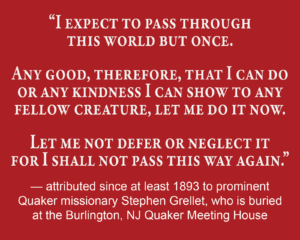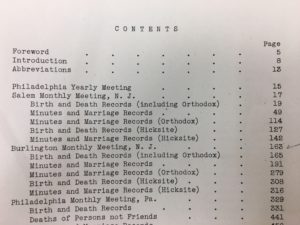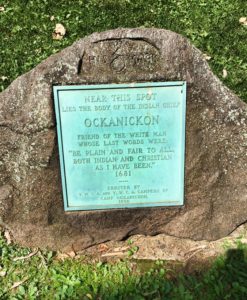Genealogy is below
It is believed that a portion of this ground was used for burials from the earliest settlement of the town, 1678, although the first deed for the property is dated 1692.
Chief Ockanickon
Behind the Meeting House, near the giant American Sycamore tree, is a boulder with a plaque bearing the inscription – “Near this spot lies the body of Indian Chief Ockanickon, Friend of the White Man, whose last words were ‘Be Plain and Fair to all both Indian and Christian, as I have been’. 1681.” Chief Ockanickon of the Mantas Lenape tribe assisted William Penn in the exploration of the Bucks County area.
 Notable Quakers
Notable Quakers
William Allinson, publisher of “Friends Review”
Grace Buchanan, the druggist in Burlington
Samuelle Hilles, first Superintendent of the Haverford School
John Griscom, professor of Chemistry at Columbia College in NYC
Nathanial Coleman, silversmith in Burlington
Isaac Collins, printer to the King George III for the Province of New Jersey in 1770, publisher of the “New Jersey Gazette” and printer of the Provincial Currency
Stephen Grellet, a prominent French-born American Quaker missionary. Born to the son of a counsellor of King Louis XVI. During the French Revolution he was sentenced to be executed, but escaped to the United States in 1795. In 1796 he joined the Society of Friends. He was granted meetings with many rulers and dignitaries, including Pope Pius VII, Czar Alexander I, and the Kings of Spain and Prussia.
John Gummere, proprietor of the boarding school in Burlington, Superintendent of Haverford College 1835, mathematician, published “Gummer’s Astronomy and Surveying”
Sammuel Gummere, proprietor of a boarding school for girls, built and occupied what is now the central part of St. Mary’s Hall, Clerk in Chancery in Trenton
William Gummere, officer of the National Bank of the Northern Liberties. From a clerk, rose to be President and President Emeritus
Stephen Pike, authored “Pike’s Arithmetic,” bookseller opposed to dealing in works of fiction
Elizabeth Paul Kirkbride Gurney, prominent Quaker minister in U.S. and British Isles. The Civil War presented a dilemma for the Eliza: her anti-slavery beliefs and pacifism were strong, but she wanted the North to win the war. In October 1862, Eliza, along with 3 other Friends, made a personal visit to Abraham Lincoln. She assured the President of the support of the Friends in his endeavor to end slavery and the war. She then prayed with him. Nearly a year later, Eliza received a special request from the President, through Isaac Newton, U.S. Commissioner of Agriculture, that she would write to him, which she did on August 18, 1863. On September 4, 1864, Lincoln wrote to Eliza, a woman who brought out an e specially thoughtful side of the President. Eliza responded to his letter on September 8, 1864. When President Lincoln was assassinated, Eliza’s letter, written nearly two years previously, had been carefully “treasured up” by him, and was in his breast pocket when the fatal shot struck him.
Peter Hill, was one of 11,423 enslaved African Americans residing in New Jersey in 1790. At a young age, Hill learned the craft of making clocks from his master, Joseph Hollinshead, Jr. Requiring metalworking skills, a mechanical mind and precision handiwork, clock making was a highly-prized skill in early New Jersey and Hill soon demonstrated an ability that equaled that of his mentors. Tall clocks were the biggest, most expensive items in colonial American homes. The comparatively high price of forty collars made them a commodity only for the wealthy. His works are in the Smithsonian National Museum of American History, New Jersey State Museum and Philadelphia Museum of Art. Funds were raised and headstone placed for Hill in 2019
James Kinsey, a Delegate from New Jersey; born in Philadelphia, Pa., March 22, 1731; attended the common schools; studied law; was admitted to the New Jersey bar in 1753 and practiced in the courts of Pennsylvania and New Jersey, with residence in Burlington County, N.J.; member of the State general assembly 1772-1775; member of the committee of correspondence for Burlington County in 1774 and 1775; Member of the Continental Congress from July 23, 1774, until his resignation effective November 22, 1775; appointed chief justice of the supreme court of New Jersey on November 20, 1789, and served until his death in Burlington, N.J., January 4, 1803; interment in Friends’ Burial Ground.
Caroline Luango, a young African girl who died in passage
Edmund Morris, editor of the “Bucks County Intelligencer” and “Trenton State Gazette”, newspaper correspondent during the Civil War to the “Philadelphia Press” and the “New York Tribune,” first in U.S. to print in color, author of “Ten Acres Enough” and “How to Get a Farm and Where to Find One.”
Margaret Morris, considered the first practicing female physician
Margaret Smith, aided strangers who were injured in the great railroad accident in Burlington in 1855
Samuel Smith, poet
Warren Smith, age 79, of Trenton, NJ, died on Monday, March 27, 2000 at his home. He was born in Philadelphia, PA and relocated to the Burlington County area where he was educated in the public school system. He was a veteran of the U.S. Army and served during World War II. He attended Mercer County Community College, Trenton, NJ. Warren was formerly employed by the Social Security Ad ministration in Trenton, NJ.
William Ridgway, sea captain trading in Europe and West Indies
Dr. Joseph W. Taylor, Founder of Bryn Mawr College
Burr Woolman, surveyor in New Jersey for 40 years
Headstones
1706-1733 the Religious Society of Friends decided “that no monuments of either wood or stone be affixed to graves in any of our burial-grounds; and if any yet remain therein that these be forthwith removed…” A number were removed and number were buried beneath the surface.
The oldest dated marker appears to be “D.B. 1726.”
Plots
List
Click here for a .PDF (9 MB) of a “List of graves in Friends Burial Ground, Burlington, N.J.” to go with the blue print map made in 1870 by William F. Newbold.
Map
Click here or on the image below for a .PDF (2.4 MB) of a copy of the blue print map made in 1870 by William F. Newbold, updated in March 1975 by H.S. Haines. Note that the giant American Sycamore tree behind the Center for Conference is labeled as “Buttonwood Tree” (the names are synonymous) on the map.
Markings and inscriptions of a number of gravestones
Friends’ Burial-Ground, Burlington, New Jersey (continued)
Rowland J. Dutton
The Pennsylvania Magazine of History and Biography
Vol. 24, No. 2 (1900) (pp. 149-164)
Page Count: 16
Quaker History & Genealogy
Burlington Meeting Records
http://archives.tricolib.brynmawr.edu/repositories/9/resources/5634
http://archives.tricolib.brynmawr.edu/repositories/9/resources/5396
 The Burlington County Historical Society has the book the Encyclopedia of American Quaker Genealogy by William Wade Hinshaw, Volume II, in which you can find Burlington Monthly Meeting:
The Burlington County Historical Society has the book the Encyclopedia of American Quaker Genealogy by William Wade Hinshaw, Volume II, in which you can find Burlington Monthly Meeting:
Birth and Death Records (including Orthodox)
Minutes and Marriage Records
Minutes and Marriage Records (Orthodox)
Birth and Death Records (Hicksite)
Minutes and Marriage Records (Hicksite)
On Wed. and Thurs. from 1 to 5 a person can use the Society’s research library resources for the day for $5. During Covid restrictions, the Society’s Genealogist Ellen Fayer will do detailed searches for a $50 fee.
Other Records
Many, many links
https://www.americanancestors.org/education/learning-resources/read/quaker-guide
Research Guide to Finding Your Quaker Ancestors by Ancestry.com
https://www.ancestrycdn.com/mars/landing/quaker/quaker-guide.pdf

